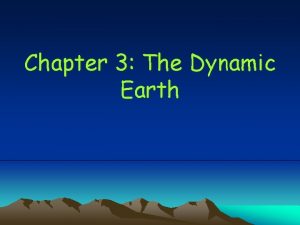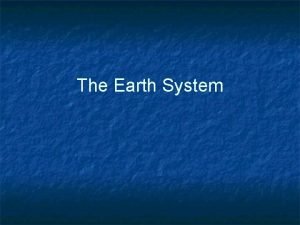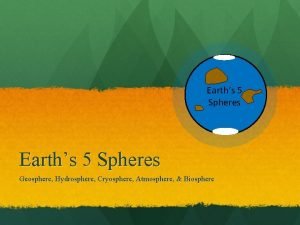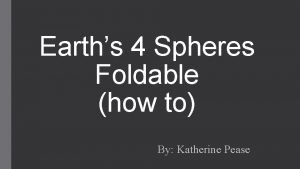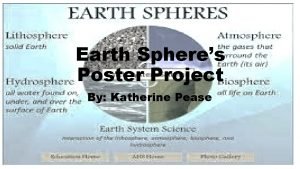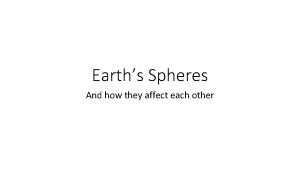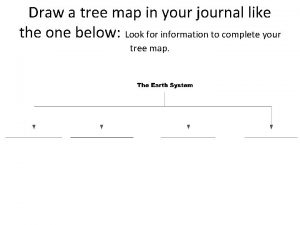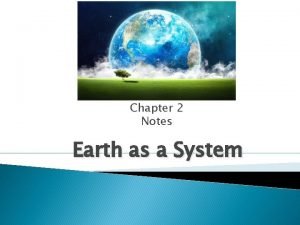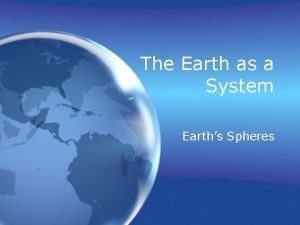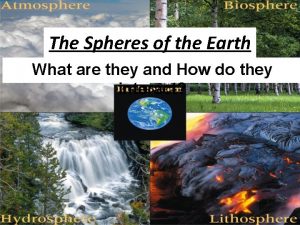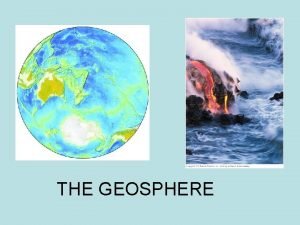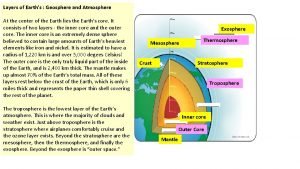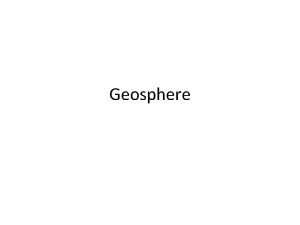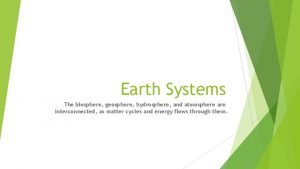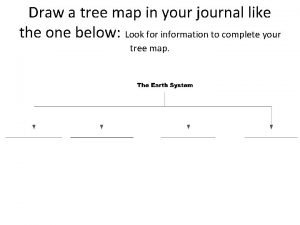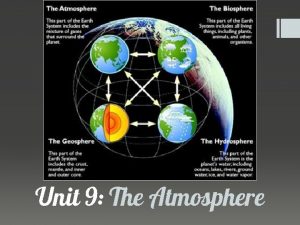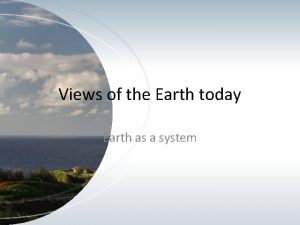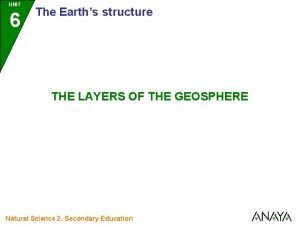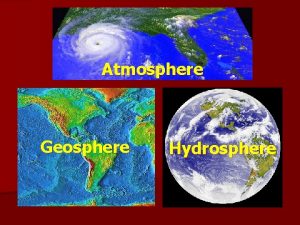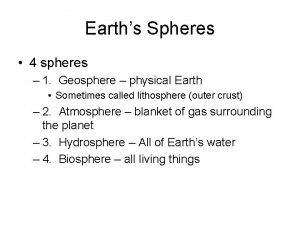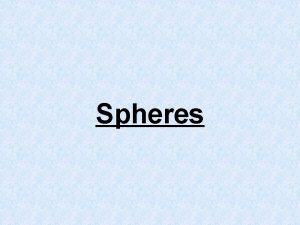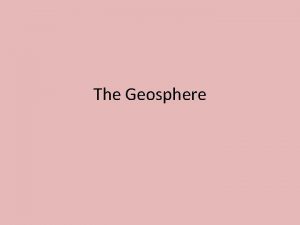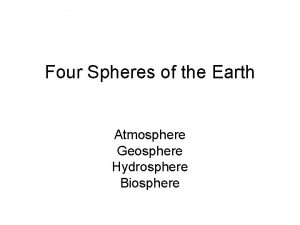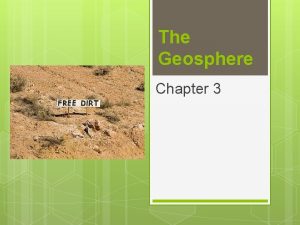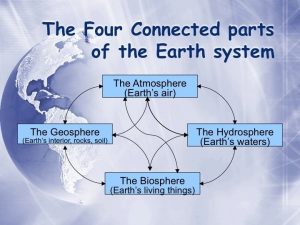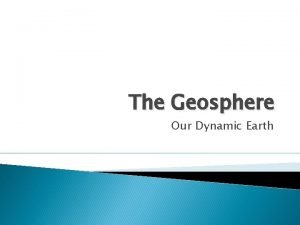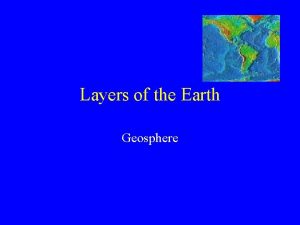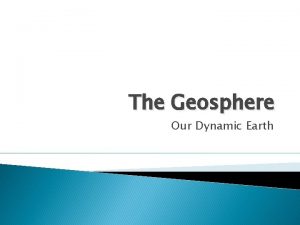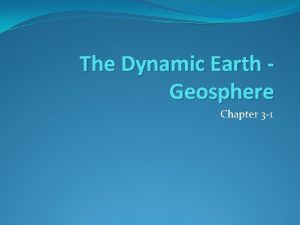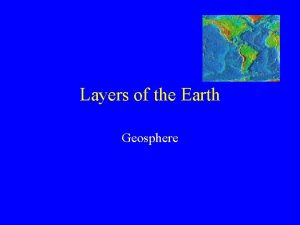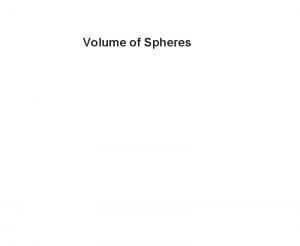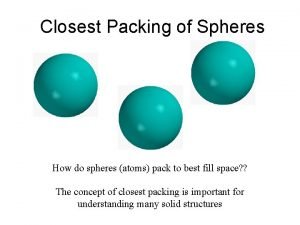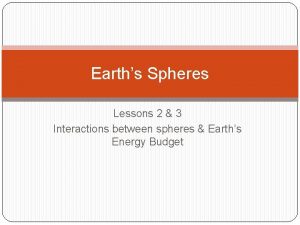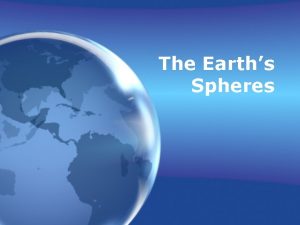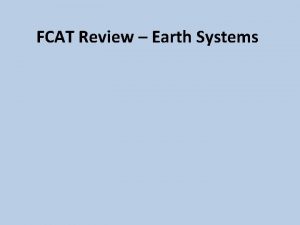Spheres of the Earth Earth Systems Geosphere All

























- Slides: 25

Spheres of the Earth

Earth Systems Geosphere • All layers of the solid earth Hydrosphere • All earth’s water Atmosphere • Outermost system • Mixture of gases and particles Biosphere • All living things • Within all other systems • On land, water, and air

Hydrosphere v. All Earth’s water


Hydrosphere v. Condensation v. Evaporated water changes from gas to a liquid v. Gathers with dust to form v. Evaporation clouds v. Liquid water changes to a gas and rises into the atmosphere v. Transpiration v. Water evaporates out of v. Precipitation v. Condensation and water falls to earth as rain or snow v. Collection v. Water collects as runoff or groundwater


Ocean Currents v. Ocean Currents--“Stream-like” movements of water v. Surface Currents v. Occur near the surface v. Caused by wind v. Depths of 100 -1000 meters

Ocean Currents v. What Affects Surface Currents? v. Continental Deflections v. Currents change direction when they meet continents

Ocean Currents v. What Affects Surface Currents? v. Coriolis Effect v. Earth’s rotation causes moving air and water to appear to move to the right in the northern

Ocean Currents v. What Affects Surface Currents? v. Global Winds v. Winds that blow across the surface of Earth’s oceans push water across Earth’s

Ocean Currents v. What Powers Ocean Currents? v. The Sun v. Heats up water at the Equator v. Gravity v. Warm, less dense water goes up

Ocean Currents v. Deep Currents v. Occur far below surface v. Caused by differences in water density v. Salinity v. More salt, more density v. Temperature v. Colder temperature, more density

Atmosphere v. A thin layer of gases surrounding Earth

Atmosphere v. Composition v. Gases v. Nitrogen=78% v. Oxygen=21% v. Other gases(water vapor, argon, carbon dioxide)=1% v. Solids and Liquids v. Dust, pollen, salt, volcanic ash v. Water droplets, acids

Atmosphere v. Importance v. Contains oxygen, carbon dioxide, and water necessary for life v. Keeps Earth’s temperatures within a survivable range v. Protects living things from Sun’s harmful rays v. Protects Earth’s surface from being struck by meteors

Atmosphere v. Origin 1. Gases from erupting volcanoes on early Earth emitted hot gases, gases formed atmosphere 2. Early atmosphere was mostly water vapor 3. As Earth cooled, water vapor condensed and fell in liquid form 4. Water cycle occurred for thousands of years 5. First organisms used photosynthesis, removing CO 2 and giving off O 2

Atmosphere v. Circulating Air v. Affects weather and climate around the world v. Warm, less dense air rises v. Cool, more dense air sinks

Energy From the Sun v. Radiation v. Transfer of energy by electromagnetic waves

Energy From the Sun v. Radiation v. Visible light v. Light you can see v. Converted to thermal energy (heat)

Energy From the Sun v. Radiation v. Ultraviolet Light-UV v. Short wavelengths v. Burns human skin v. Causes skin cancer

Energy From the Sun v. Radiation v. Infrared Light-IR v. Longer wavelengths v. Felt as warmth

Energy on Earth Solar Radiation Reflected by land sea; 5% Absorbed by atmosphere; 20% Reflected by clouds; 25% Absorbed by Earth; 50% Absorbed by atmosphere Absorbed by Earth Reflected by clouds Reflected by land sea

Energy on Earth v. Absorption v 20% of sun’s radiation absorbed by particles in atmosphere v 50% of sun’s radiation absorbed by Earth’s surface v. Reflection v 25% of sun’s radiation is reflected by clouds and particles v 5% of sun’s radiation is reflected by land sea surfaces

Energy From the Sun v. Radiation Balance v. Amount of radiation earth receives from sun is the same as the amount radiated back into the atmosphere

Energy From the Sun v. Greenhouse Gases v. Greenhouse gases=water vapor, carbon dioxide and methane v. Gases in atmosphere let in sunlight v. Gases trap some radiation and direct it back to earth v. Radiation builds up on earth’s surface as thermal energy
 Chapter 3 the dynamic earth section 1 the geosphere
Chapter 3 the dynamic earth section 1 the geosphere 3.how can you compare the terrarium to an earth system
3.how can you compare the terrarium to an earth system What are the four spheres of the earth
What are the four spheres of the earth 5 spheres of earth
5 spheres of earth Earth's spheres foldable
Earth's spheres foldable Four spheres poster
Four spheres poster Earth sphere interactions
Earth sphere interactions Living soil vs dead soil
Living soil vs dead soil Earth's spheres
Earth's spheres Hydrosphere concept map
Hydrosphere concept map Earth systems foldable
Earth systems foldable 4 spheres of the earth
4 spheres of the earth The four spheres
The four spheres Spheres of the earth
Spheres of the earth Name a point that is collinear with the given points
Name a point that is collinear with the given points Geosphere examples
Geosphere examples The geosphere is made up of
The geosphere is made up of Defenition of earth
Defenition of earth The layers of the geosphere
The layers of the geosphere What is in the geosphere
What is in the geosphere Geosphere
Geosphere How to draw a tree map
How to draw a tree map Geosphere vocabulary
Geosphere vocabulary What is geosphere made of
What is geosphere made of Geosphere
Geosphere Geosphere diagram
Geosphere diagram
